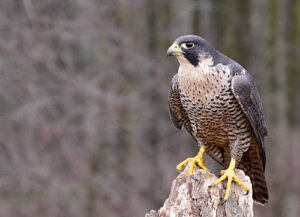THE PEREGRINE FALCON

By Terri Estes
Did you know that there is a pair of peregrine falcons that nest on the Marine Parkway Bridge? It’s true! In May 2021, two healthy baby falcons were born in a manmade nesting box atop the south tower of the Marine Parkway Bridge. In 2022, one baby falcon was born on June 15 in the same nest, to the same parents. The chick, named Tillie by the NYS DEP, appeared healthy and was banded for future identification and tracking. The NYS DEP has placed manmade nesting boxes just like this one on the Verrazano Bridge and the Throgs Neck Bridge.
Peregrine falcons mate for life. They typically lay three to four eggs, and the incubation lasts 29-32 days. Chicks fledge at around 35-42 days. Both parents contribute to incubating the eggs and raising the young. As the chicks grow, both parents are involved in teaching them essential skills for survival, such as hunting and flying. These are very territorial birds and both male and females are active in protecting the nest and their territory from potential threats.
The peregrine falcon is the fastest bird in the world and can reach speeds of over 200 miles per hour during a dive, which is called a stoop, when they are hunting. They are known for catching their prey in mid-air. The force with which they hit their prey usually kills their target instantly. While they are known for inhabiting remote cliffs, they have adapted well to urban environments and are known to nest on skyscrapers, bridges and other tall, manmade structures. From these heights they can target pigeons, seagulls, rats and other urban dwellers for their dinners.

This is a striking bird with a sleek powerful build. They have a wingspan of about three and a half feet and stand 15-20 inches tall. Adult peregrines have a blue-gray back and wings, a white face with dark markings, and a black “hood” that extends down to the eyes. Their underside is white or pale with black barring. Juvenile peregrines remain brown and cream colored until they are one year old.
The peregrine falcon is still on the endangered list, but through conservation efforts, they have made a remarkable comeback. The agricultural use of DDT had devastating effects on peregrine falcons and other birds of prey. By the 1960s and 1970s, the peregrine falcon had all but disappeared from New York and many other regions of the country. This led to the ban on DDT in the United States in 1972. As of 2019, we have approximately 25 pairs of nesting peregrine falcons in the five boroughs, including our own local pair right here on the Marine Parkway Bridge.


